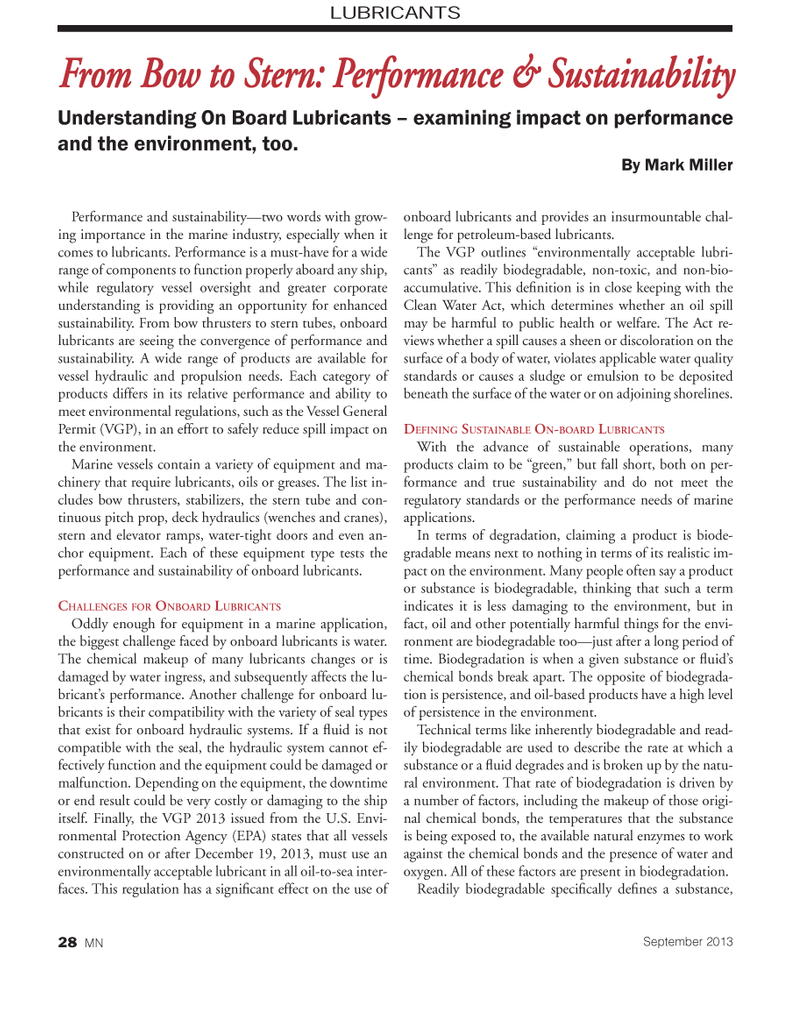
Page 28: of Marine News Magazine (September 2013)
Workboat Annual
Read this page in Pdf, Flash or Html5 edition of September 2013 Marine News Magazine
Performance and sustainability?two words with grow- ing importance in the marine industry, especially when it comes to lubricants. Performance is a must-have for a wide range of components to function properly aboard any ship, while regulatory vessel oversight and greater corporate understanding is providing an opportunity for enhanced sustainability. From bow thrusters to stern tubes, onboard lubricants are seeing the convergence of performance and sustainability. A wide range of products are available for vessel hydraulic and propulsion needs. Each category of products differs in its relative performance and ability to meet environmental regulations, such as the Vessel General Permit (VGP), in an effort to safely reduce spill impact on the environment. Marine vessels contain a variety of equipment and ma- chinery that require lubricants, oils or greases. The list in- cludes bow thrusters, stabilizers, the stern tube and con- tinuous pitch prop, deck hydraulics (wenches and cranes), stern and elevator ramps, water-tight doors and even an- chor equipment. Each of these equipment type tests the performance and sustainability of onboard lubricants. CHALLENGES FOR ONBOARD LUBRICANTS Oddly enough for equipment in a marine application, the biggest challenge faced by onboard lubricants is water. The chemical makeup of many lubricants changes or is damaged by water ingress, and subsequently affects the lu- bricants performance. Another challenge for onboard lu- bricants is their compatibility with the variety of seal types that exist for onboard hydraulic systems. If a ? uid is not compatible with the seal, the hydraulic system cannot ef- fectively function and the equipment could be damaged or malfunction. Depending on the equipment, the downtime or end result could be very costly or damaging to the ship itself. Finally, the VGP 2013 issued from the U.S. Envi- ronmental Protection Agency (EPA) states that all vessels constructed on or after December 19, 2013, must use an environmentally acceptable lubricant in all oil-to-sea inter- faces. This regulation has a signi? cant effect on the use of onboard lubricants and provides an insurmountable chal- lenge for petroleum-based lubricants. The VGP outlines environmentally acceptable lubri- cants? as readily biodegradable, non-toxic, and non-bio- accumulative. This de? nition is in close keeping with the Clean Water Act, which determines whether an oil spill may be harmful to public health or welfare. The Act re- views whether a spill causes a sheen or discoloration on the surface of a body of water, violates applicable water quality standards or causes a sludge or emulsion to be deposited beneath the surface of the water or on adjoining shorelines. DEFINING SUSTAINABLE ON-BOARD LUBRICANTS With the advance of sustainable operations, many products claim to be green,? but fall short, both on per- formance and true sustainability and do not meet the regulatory standards or the performance needs of marine applications. In terms of degradation, claiming a product is biode- gradable means next to nothing in terms of its realistic im- pact on the environment. Many people often say a product or substance is biodegradable, thinking that such a term indicates it is less damaging to the environment, but in fact, oil and other potentially harmful things for the envi-ronment are biodegradable too?just after a long period of time. Biodegradation is when a given substance or ? uids chemical bonds break apart. The opposite of biodegrada- tion is persistence, and oil-based products have a high level of persistence in the environment. Technical terms like inherently biodegradable and read- ily biodegradable are used to describe the rate at which a substance or a ? uid degrades and is broken up by the natu- ral environment. That rate of biodegradation is driven by a number of factors, including the makeup of those origi-nal chemical bonds, the temperatures that the substance is being exposed to, the available natural enzymes to work against the chemical bonds and the presence of water and oxygen. All of these factors are present in biodegradation. Readily biodegradable speci? cally de? nes a substance, From Bow to Stern: Performance & Sustainability From Bow to Stern: Performance & Sustainability Understanding On Board Lubricants ? examining impact on performance and the environment, too. By Mark MillerLUBRICANTSSeptember 201328 MNMN Sept2013 Layout 18-31.indd 288/29/2013 11:16:37 AM

 27
27

 29
29
